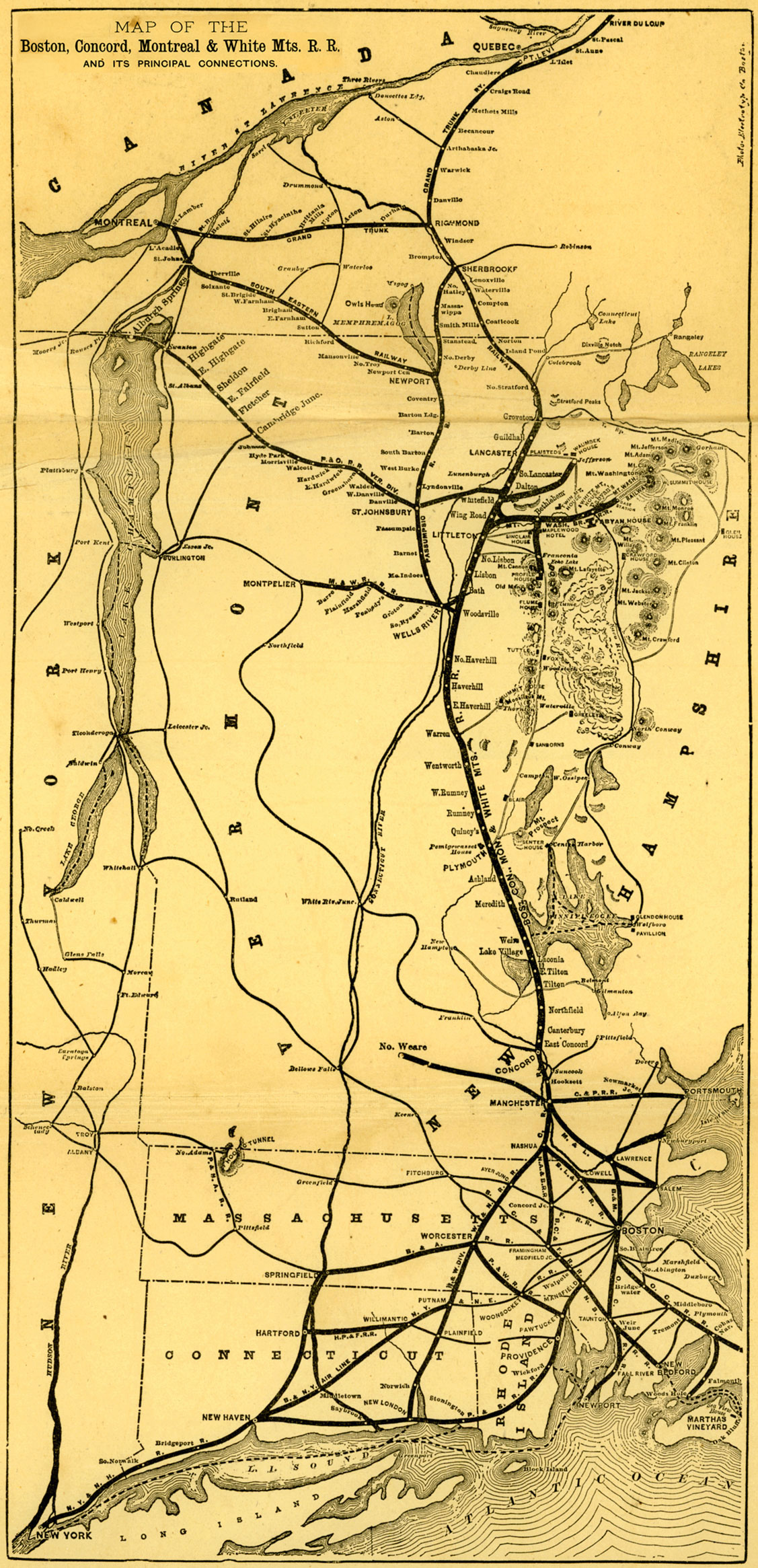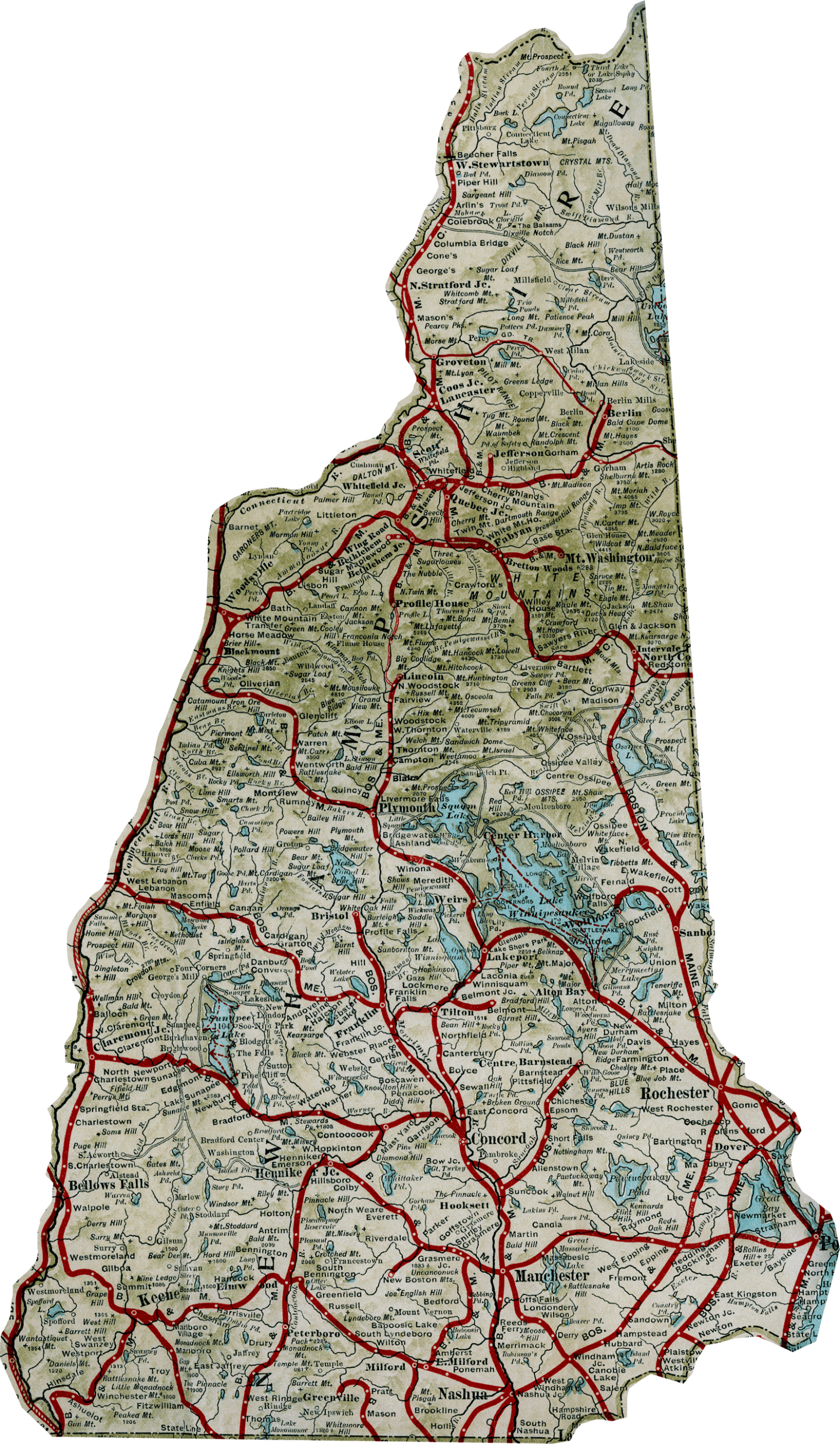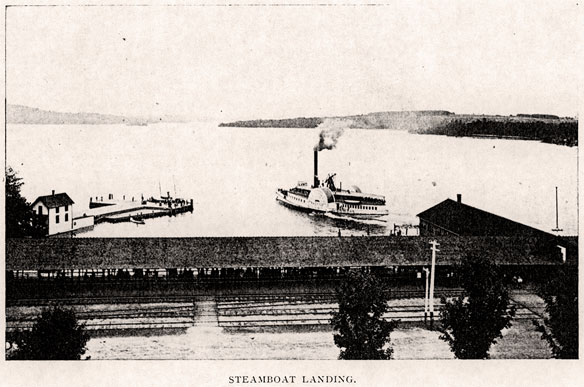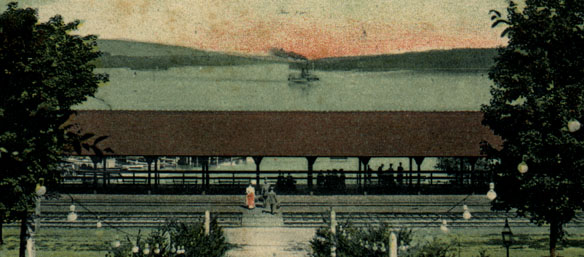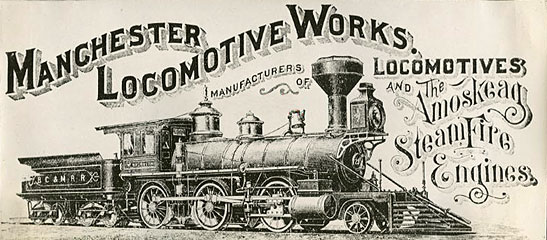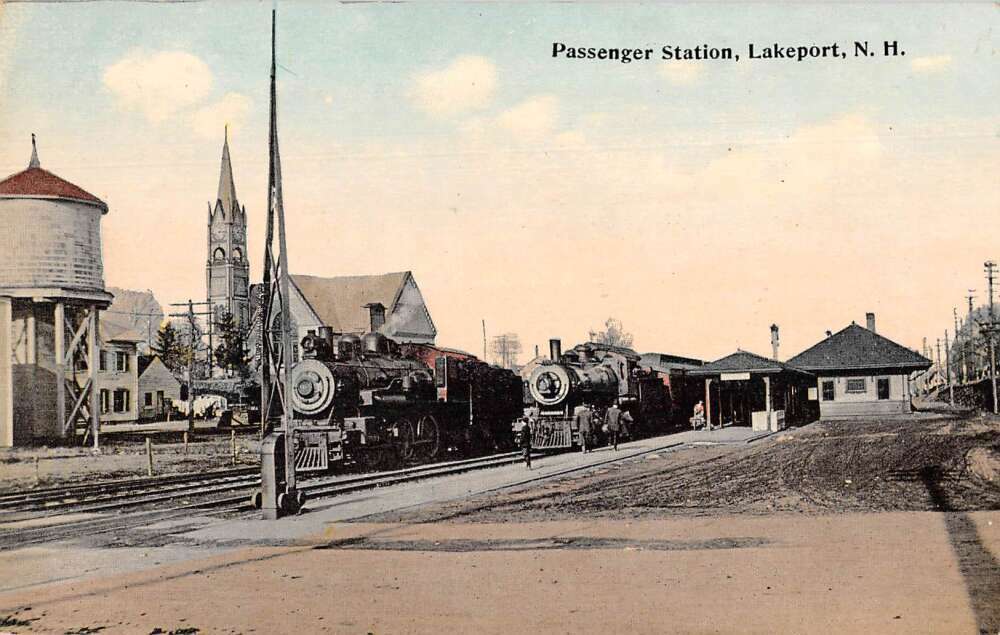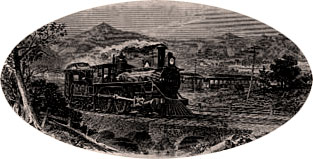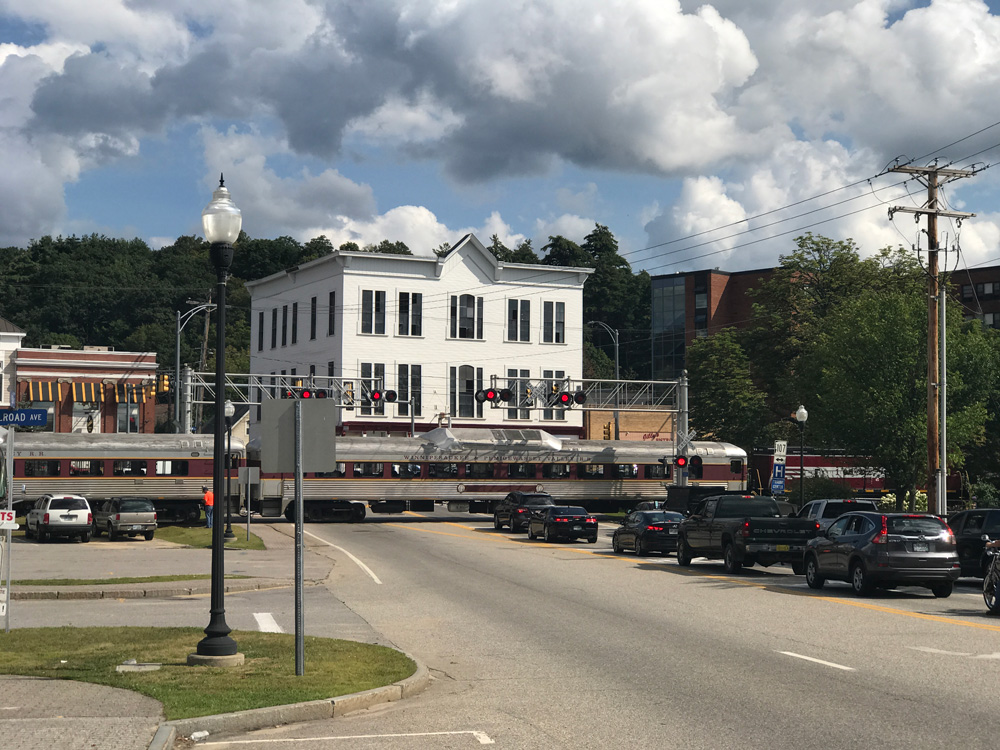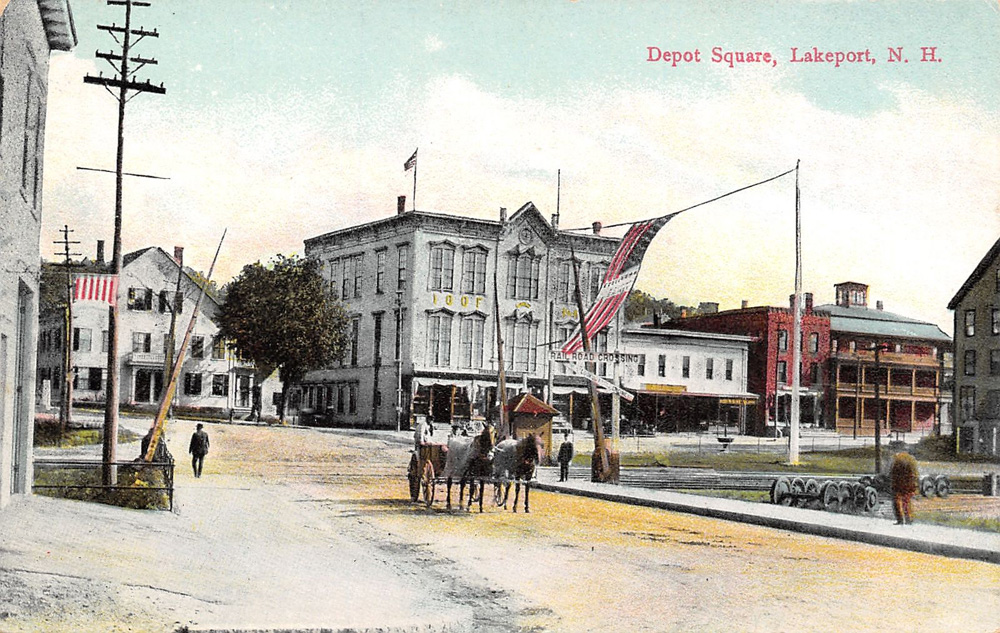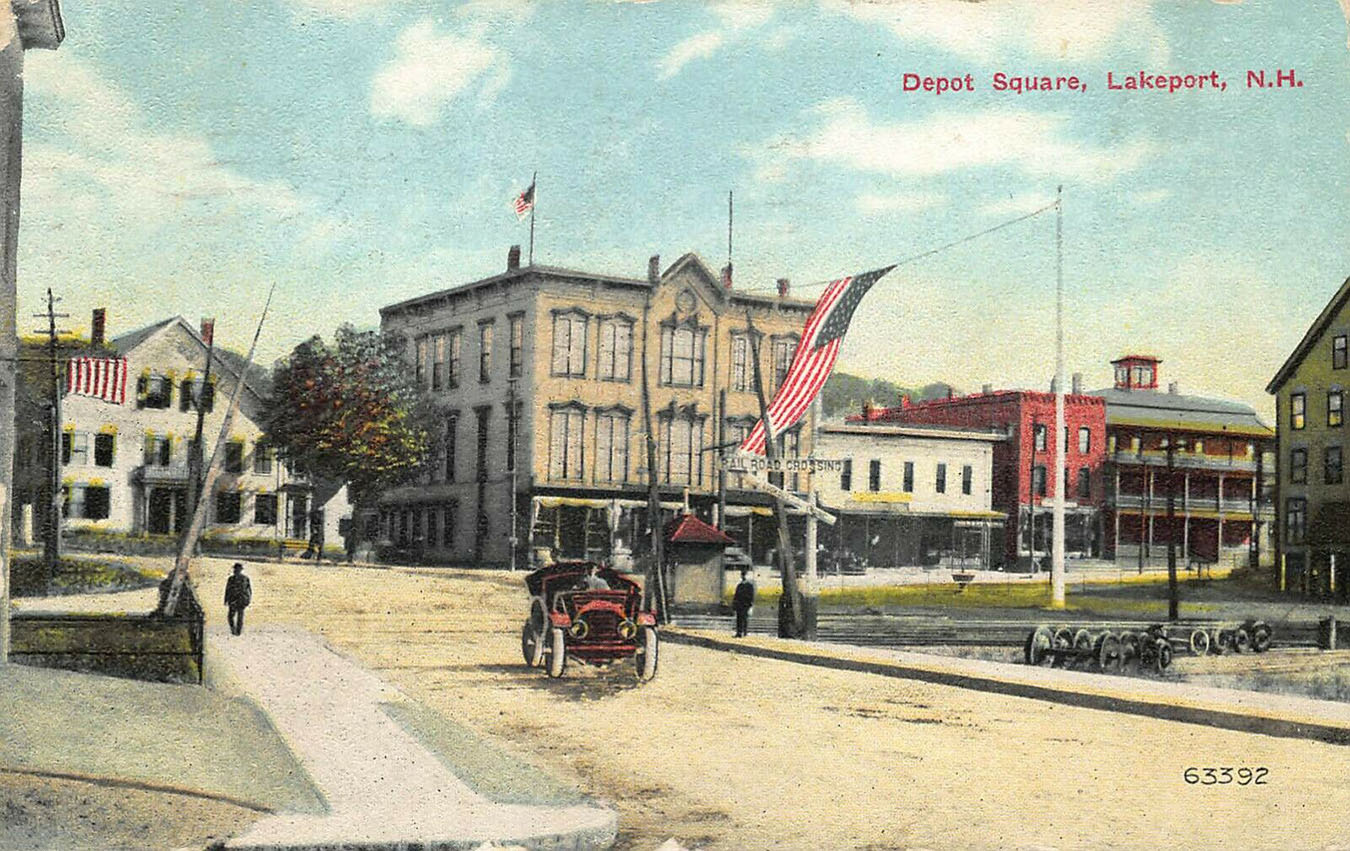Railroads
When did tourists begin to arrive in Weirs Beach?
BC&M System Map 1880-1882. Click here for more info and BC&M maps from 1845, 1875, and 1878.
Construction of the Railroad
Around December 1, 1848, the Boston, Concord, and Montreal railroad reached Weirs Beach, making it easily accessible to New Englanders. When the railroad reached the downtown area of Laconia on August 8, 1848, it prompted the “biggest celebration the town had ever witnessed up to that point.*” Meredith was reached by March 19, 1849. Weirs Beach was reached about halfway between these two dates.
Continuing construction of the railroad past Weirs Beach, its easternmost point, the BC&M swung to the Northwest, reaching Plymouth, NH (mile 51) on January 21, 1850. The more mountainous terrain ahead proved more difficult to traverse, requiring at Glencliff a 3/4-mile-long deep cut. The end of the line (mile 92) was eventually reached in Woodsville, NH, around 1852. An essential one-mile spur from Woodsville, bridging the Connecticut River to Wells River, VT, and connecting to the Connecticut and Passumpsic (rivers) railroad (and thereby to the Central Vermont railroad, which ran on to Montreal), was finally completed on May 10, 1853.
To service the new railroad, the BC&M decided to build a railyard at about the midway point in the line. Lakeport was about halfway between Concord and Woodsville, so it became the location of the main repair and maintenance shops for the BC&M. Nineteenth century maps and photos of Lakeport show the many buildings that were built. They did not last long. By 1900, the B&M railroad, which had taken over the BC&M, had shifted the main railyard for the BC&M and 3 other lines to Concord, NH. The six-acre Concord facility employed 1,300 workers and serviced over 400 freight cars and 50 passenger cars a month. The football-sized main building could service 48 cars at a time.
*For the August 8, 1848 celebration, “A mammoth cannon was located near Horse Point, on the shore of Lake Winnisquam, and when the special train came along, a salute was fired, which was the signal for ringing the mill bells, and the church bell of the old North church. There was an immense throng of people waiting at the depot to welcome the iron horse, the farmers driving in from miles around. The chief feature of the celebration was the collation (a light meal), served by the ladies of the village in the freight depot, which stood on the site of Laconia’s beautiful passenger station of today. The car track stopped near this point.” (The Illustrated Laconian, page 9).
Name of the Town
Weirs Beach was commonly known in the latter half of the nineteenth century as “Weirs Steamboat Landing“, or simply, “Weirs Landing”. So, when a century later, the town became Weirs Beach, it was not the first time a descriptive had been added to the name of the town. In fact, the town has also been called (and often misspelled) at least 9 other ways over the years! 1)Weirs 2)Weirs Station 3)Weirs Bridge 4)Weir’s Bridge 5)The Wiers 6)The Weirs 7)The Weirs P.O. 8)Wares and 9)Weit’s. (From various 19th century maps of NH).
To this day, locals still refer to the town as “The Weirs” instead of as Weirs Beach. A 1926 Laconia Democrat article noted that “…the popular summer resort is correctly called The Weirs and not Weirs. Laconians know that The Weirs is the one and only way to print the name. The ‘The’ is important”.
Growth and Decline
Click to see a gallery of pictures of the train canopy that covered the boardwalk during the 1893-1939 Third Weirs Beach Train Station.
Weirs Beach grew to become one of the most popular tourist destinations in New England. By the turn of the century, four express trains left Boston’s Union Station each day bound for Weirs Beach.
The heyday of train service to Weirs Beach ran from about 1885 until about 1910. During this period, rail service was extensively promoted with brochures and various guidebooks. The printed marketing materials contained extensive descriptions of the highlights for visitors to the area, multiple fold-out maps, and detailed timetables. For a photo gallery of these brochures and booklets, click here.
The Boston & Maine railroad gradually gained control of other railroad lines until by 1915, it controlled 2300 route miles of track, traversed by 1200 steam locomotives, and had 28,000 employees. The B&M railroad linked hundreds of towns in the northern New England states to Canada, New York, and beyond. By 1915, the B&M controlled over 90% of the 1260 miles of railroad lines in New Hampshire.
After peaking in 1915, train service from Boston to Weirs Beach began a long, slow decline, culminating with the end of year round service in October of 1959. A limited summer service was offered for the next few years, until it too was ended, in 1965.
The Weirs Beach train station was open year round until 1940; but from 1941-1951 the station was only open 7 months a year, from April 1-October 31. From 1952 through 1959, the station was only open 5 months a year, from May 15 – October 15. After only selling 199 train tickets the entire season of 1959, the station closed permanently.
Click here for a 2011 map showing the status of railroad lines in New Hampshire. By 2001, only 459 miles of line were being used. As can be seen from this map, the tracks all the way from the MA-NH border to Weirs Beach are still being maintained. The B&M maintains its line as far north as Concord, and the state of NH is maintaining the branch from Concord that passes Weirs Beach on its way to Lincoln, NH. Therefore, there is no physical reason why train service from Boston to Weirs Beach could not be revived, only economic ones.
According to a Laconia Daily Sun newspaper article, dated April 27, 2007, a railroad authority was proposed for NH to “plan, design, build and manage future commuter and tourist lines”, including “a commuter rail from Manchester to Nashua and Lowell, with connections to Boston.” This commuter rail plan “has already received substantial federal funding, and most of the designs are completed”; and efforts are being made to “define this project as reaching all the way north to the state capital”. If this project was to actually get built, particularly to Concord, revival of service to Weirs Beach at some point in the future could become a real possibility.
However, another Laconia Daily Sun article, dated September 5, 2007, throws cold water on the whole idea. Judge Barbado of the US District Court in Concord denied the Conservation Law Foundations’s request for a feasibilty study for a commuter railroad in the median of the planned widening of a 20-mile stretch of Interstate 93 in Southern NH, or in the abandoned Manchester-Lawrence railroad corridor. NH State Representative Fred King, R-Colebrook, commenting on the ruling, said “The people pushing for railroads are crazy. Nobody is going to build one.” Yet, Representative Howard Cunningham (D-Center Sandwhich) pointed out that the escalating cost of widening the highway – from an initial estimate of $275 million to $805 million today – “might some day make mass transit viable in comparison.”
The best hope today for revival might lie with the New Hampshire Railroad Revitalization Association, which has been pushing since 2004 for revival of train passenger service in NH, and the New Hampshire Rail Transit Authority, which was officially established on July 17, 2007. According to a Laconia Citizen newspaper article, dated April 26, 2010, the Authority is seeking $3.5 million in federal funding for additional study of the proposed Boston to Concord “NH Capital Corridor” (NHCC) Commuter Rail service. The estimated cost to extend service from Lowell to Concord is $250-$300 million.
Timeline of the railroad line in Weirs Beach
1842 – Rail service from Boston reaches Concord, NH, spurring the desire for further expansion north.
1931 – The B&M begins Snow Train service from North Station to the five main ski regions of New Hampshire: Belknap, Dartmouth, Eastern Slope, Franconia Notch, and Littleton-Franconia. The service proves popular and continues through the 1940-1941 ski season. The Snow Train is suspended for WWII, and not revived after the war. (Click on the link for the 1939 Snow Train booklet.)
1945 – After the war, the B&M ramped up the conversion of its railroads to diesel. Diesel engines were cleaner and quieter, did not need a couple of hours to fire up, and required far less maintenance than steam engines, which needed constant repair, with about 50% of the steam locomotives out of service on any given day.
1948 – In September, the next-to-last steam engine train on the White Mountain Division of the B&M is replaced with a modern, 1500-hp diesel engine. All the other trains on the line ran diesel by now, leaving only a single steam engine running the afternoon trip to Boston and back.
1953 – The B&M modernizes the street crossing train signals throughout the City of Laconia. An article describing the upgrade can be found here.
1958 – A winter timetable is released, dated October 26, 1958, showing the last scheduled winter service to Weirs Beach. The timetable can be viewed here.
2001 – In April, NH’s latest State Rail Plan is released. The Concord-Lincoln track is rated “Class 2”, which means the maximum speed is 30mph for passengers and 25mph for freight.
2006 – Guilford Industries, which still owned the original B&M system of railroad lines, changes its names to Pan American Railways. Guilford had bought rights to the Pan Am name and logo in 1998. Why a railroad thought naming itself after an airline was a good idea is not known, but certainly the Pan Am name was widely recognized.
2008 – On the evening of August 7, severe flooding breaches the line at the Weirs Beach boardwalk and at several places northward as far as Ashland. After only a few days interuption, tourist service resumes between Weirs Beach and Meredith. Emergency repairs to the boardwalk breach section to allow the line to traverse Weirs Beach and continue southward to Lakeport are completed on August 28, just in time for the Labor Day holiday weekend. However, the damage to the line northward of Meredith is far more extensive, with numerous embankment washouts and culvert erosions that leaves the tracks suspended in air in numerous places. After a month of repairs costing around a million dollars, the line reopens from Meredith to Ashland, just in time for foliage season.
2022 – Pan Am Railways, previously known as Guilford Industries, which had purchased the original B&M system of railroad lines in 1983, is itself bought out and becomes part of CSX Transporation.
2023 – The Winnipesaukee Scenic Railroad and the Hobo Railroad are sold to the Patriot Rail Company of Jacksonville, FL. The company specializes in short-line freight railroad systems, but also has tourism experience with its ownership of the Blue Ridge Scenic Railway in Georgia.
The Elm Street Railroad Crossing
The Winnipesaukee Scenic Railroad at the Elm Street crossing in the center of Lakeport during the 2017 excursion. The building at the center of the postcard is the Lakeport Opera House.
Contrast the 2017 photo with the same view a 100 years earlier, below. In the early view, the Lakeport Opera House is marked “IOOF”, which stands for the Independent Order of Odd Fellows. This was the Chocorua Lodge #51 of the secret fraternal society. Formed in 1869, the Lodge remained in the building until 1969, when it moved to Court Street.










